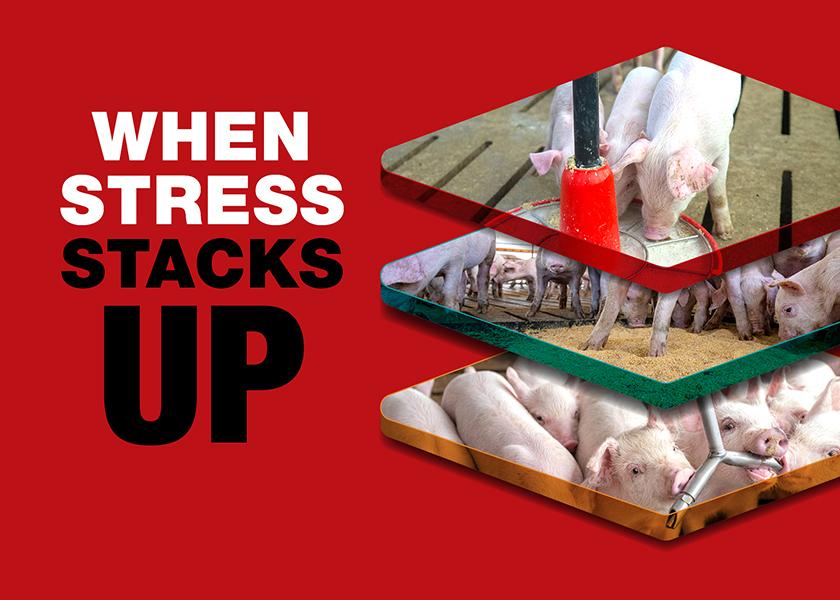When Stress Stacks Up: It’s Time to Make Weaning a Better Experience

One day, he’s hanging out with his brothers, basking in the warmth of his mom. The next day, he gets mixed in with his neighbors and finds himself in a new home with new smells, sights and sounds. Mom is nowhere in sight. Instead of warm milk, he’s being offered dry feed that doesn’t taste nearly as good. The fighting is exhausting, the fear is burdensome, and to put it simply, the newly weaned pig has a big pile of stresses stacked against him.
“I don’t think people have the proper perspective of the weaned pig,” says Denny McKilligan, Innovations leader for TechMix. “They think, ‘It’s a pig.’ But really, it’s a baby. When we teach people what a weaned pig goes through, a light bulb often comes on. People realize, ‘Oh yeah, it is a baby.’ It needs help to make such a big transition.”
Why is this important? He believes it’s necessary to understand the stacked stressors the weaned pig endures so caregivers can provide the best care possible to the pig at this stage of life.
“If we can give people a better perspective of what they are working with and instill the idea of care and being aware of what that pig goes through, what its environment is like, and simply having more empathy, that will help the pig get through a stressful time which benefits the operation in the end,” McKilligan says.
Veterinarian Tim Loula once told McKilligan, “It’s hard to shoot par if you start with a triple bogey.” McKilligan believes getting pigs off to a good start is essential for two reasons.
“First, we’ve been entrusted to these animals. We are stewards of the animals. Second, it makes sense from an economic welfare standpoint. If you can help that pig get through the stress, all of a sudden you have a pig that starts better and you improve their lifetime performance,” McKilligan explains.
How Does Stress Factor In?
Stress elicits a response in a way that is detrimental and counterproductive, explains McKilligan. Research has found the impact of stress amplifies when multiple stressors happen at the same time. In short – that’s the story of weaning.
The stacked stressors that all happen at the same time are typically counterproductive in the pig’s life. As if separation from mom isn’t enough, you now have pigs going from “milk to cornflakes” that are not as tasty or digestible as milk, he says. In addition, there’s transportation stress, fighting for hierarchy and health challenges in some herds.
How Does Stress Impact Growth and Performance?
Pipestone Nutrition's Madie Wensley sees the same trend in nursery stressors. When you consider the number of stressors wean pigs are up against, it’s no surprise starting pigs in the nursery can be challenging, points out Wensley, a nutritionist.
All of this stress can contribute to nutrient disruption. When separation occurs and pigs are presented with feed they aren’t familiar with, often in a feeder they’ve never seen before, there is a period of fasting the pigs undergo, McKilligan adds.
“They won’t eat much at all during the first 18 to 30 hours after being weaned. Once they do start eating, it is going to be variable. They will eat a little, leave it and then eat a little more. There is no average pig so to speak because each pig works out its own individual transition. We have found some pigs don’t eat and when they do eat dry food, they overconsume and gorge themselves,” McKilligan says.
When this nutrient disruption occurs the villi in the small intestine shrink, leaving them with far less absorptive capacity due to less surface area and functionality.
“It takes pigs a while to recover even when they get nutrients,” he says. “During periods of stress, nonproductive behaviors emerge, such as nutrient disruption and fighting to establish hierarchy, which ultimately cause them to use more nutrients just to sustain themselves.”
They also use vitamins and antioxidants at a faster rate due to stress. Unfortunately, this occurs at a time when they aren’t eating much feed, he says. That’s why reducing stress is key to ensure a successful weaning transition.
Does It Pay Off?
Reducing stress at weaning is important for many reasons. One mistake some operations make is expecting to see an instant return on investment for weaned pig care interventions, McKilligan points out.
“I think a lot of people expect early interventions to impact average daily gain or feed efficiency, and they very seldom do. But if you can reduce the damage resulting from the stress the pigs go through, you can increase livability,” he says. “I think we've been looking for the wrong outcomes for early care interventions.”
Part 2: When Stress Stacks Up: 8 Ways to Minimize Weaning Stress
Part 3: When Stress Stacks Up: The Secret to Weaning Success







